
9 minute read
LOST AND FOUND
LOST AND FOUND
Pitt-Bradford restores a 19th-century masterwork lost for 55 years
by KIMBERLY MARCOTT WEINBERG
A quartet of Pitt-Bradford students took part in a unique hands-on learning experience this fall that combined art, history, research and videography.
The students were involved in the university’s Emery Art Restoration Project and a documentary film being made about the conservation of the 19th-century painting and its connection to Bradford history.
The painting — a large oil canvas by Italian master artist Tommaso Juglaris — was found last year in a Bradford warehouse, having been moved there in the 1960s when the university purchased a downtown hotel to serve as its first residence hall.
The painting first came to Bradford when oil magnate and Pennsylvania State Sen. Lewis Emery, an art lover and collector, bought the painting in the early 1880s in Philadelphia after an exhibition there.
Dr. Catherine Koverola, Pitt-Bradford’s president, said, “We’re very excited to see this beautiful piece of artwork restored to its original brilliance and hanging in Blaisdell Hall. It will be a constant reminder of Pitt-Bradford’s longstanding connection to the community.”
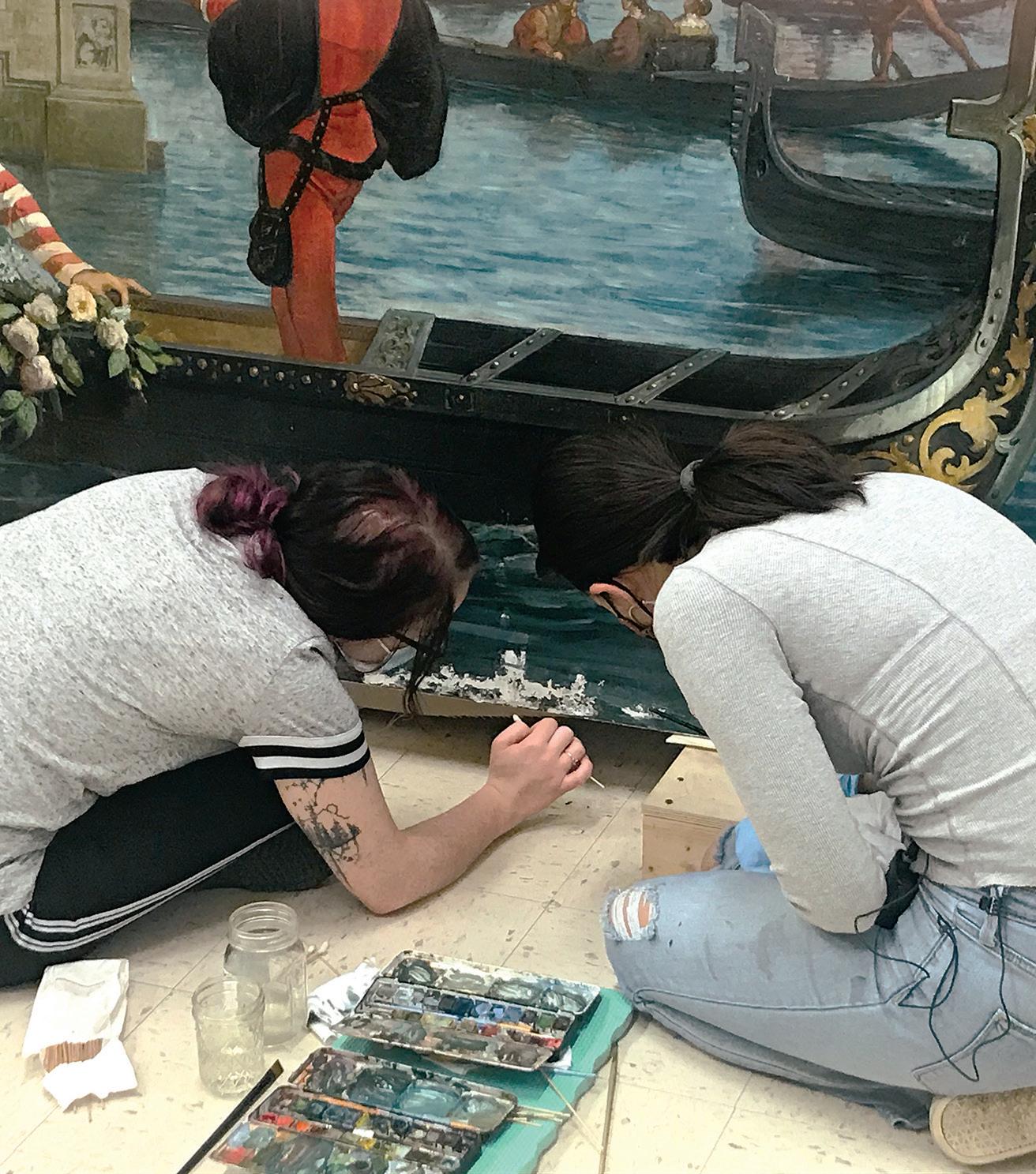
Senior Alexis Horning of Bradford, left, works alongside conservator Jacintha Clark on a portion of the damage.
Patricia Colosimo
The university plans to have an event to celebrate its new installment and show the documentary when it is safe to do so.
To restore the painting to its original beauty, Pitt-Bradford hired conservators Jeffrey Johnson and Jacintha Clark of Harrisburg to repair both the 15-foot by 9-foot painting and its large and ornate wood and plaster frame.
When “A Venetian Promenade” first arrived in America with Juglaris, it did so without a frame. The painter transported the large canvas rolled up. Each time he exhibited the painting, it would be unrolled, stretched on a canvas and exhibited. The canvas was then removed from the stretcher and re-rolled for storage or transport. Juglaris eventually sold the painting to Lewis Emery for a bargain price in order to prevent further damage to the work.
The constant bending would end up providing enough of a small space for moisture to enter between the paint layer and the canvas during its years in an unheated warehouse. To create the painting, Juglaris had applied layer after layer of thin tinted oil, which dried into a solid sheet of paint.
“The paint film itself held together,” Johnson explained, “but it was detached from the canvas.”
Before Johnson could do anything with the painting, he had to stabilize the paint so that no more would fall off by reattaching it to the canvas. Johnson first inserted a fine, medical grade needle between the paint layer and the canvas and injected conservation-grade adhesive.
With the paint securely in place, Johnson took the painting and its frame to his workshop in Harrisburg, where he removed the canvas from its stretcher, cleaned the existing paint and filled in where paint is missing.
Cleaning began by removing the varnish. Nineteenth-century oil paintings were regularly finished with a coat of varnish applied on top of the paint film after it had completely dried. The varnish – often called a sacrificial layer – protected the surface of the painting and could be removed without damaging the paint below.
Over many years, the varnish yellows, changing the appearance of the colors in the painting. Using their knowledge of the probable varnishes used at the time the painting was originally painted, Johnson and his assistant, Jacintha Clark, carefully applied various solvents to small test patches to see what would remove the varnish safely to reveal the painting’s true colors beneath. As they removed the varnish, decades of dirt and atmospheric grime went with it.
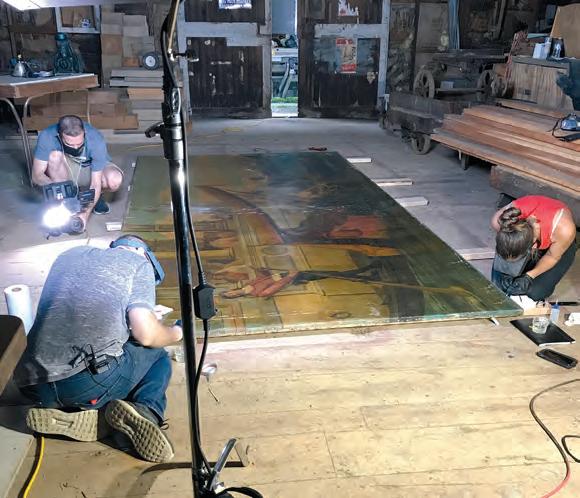
Conservators stabilize the painting in the warehouse where it was found.
Patricia Colosimo
In order to work on a piece so large, Johnson had to build a new table in his studio. While cleaning and restoring the centermost parts of the painting, he said, conservators laid foam on the canvas and sat on it.
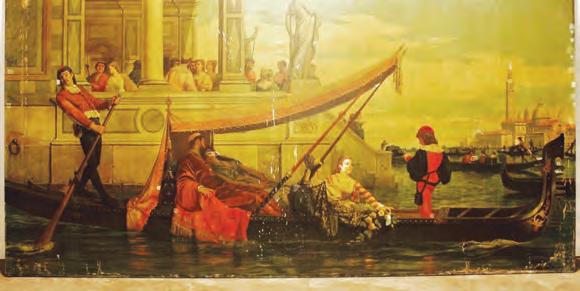
The original condition of the painting.
Patricia Colosimo
“It was a drastic change,” he said of the cleaned painting. “It looks as close to the way he painted it as it can. The painter’s colors have come back.”
After removing varnish and other old repair work down to the original paint, Johnson applied a new thin coating of varnish to preserve the original work.
Next, the team evened out the painting’s surface. Johnson explained that oil paint is applied in layers that can be as thick as a few sheets of paper. Just like a wall with peeling paint needs to be spackled, Johnson and Clark built up the surface before concocting historically accurate pigments to repaint in the missing parts.
When exposed under black light, each newly painted part glows, which can show conservators of the future where repairs were made.
Johnson then reinforced the brittle, original canvas by gluing it to a new piece of canvas using reversible thermoplastic adhesives.
“We actually laid the painting face down on our conservation table, applied a solvent-based adhesive, then laid the new canvas with its adhesive onto the original canvas,” Johnson explained.
“We carefully and methodically ironed the back of the new canvas to heat both of the adhesives to right around 150 degrees. We constantly monitored the temperature of the canvas with an infrared thermometer as we ironed to make sure we were not getting the mix too hot, which could damage the original paint film. As the adhesives cool, they become one, but always reversible at around 150 degrees.”
Now clean and stable, the painting was ready to return to Bradford. It arrived in November at its new home – Blaisdell Hall – where it will eventually hang in the KOA Speer Electronics Lobby.
Here, work would continue on “infill” painting and the restoration of the frame while a documentary film crew conducted interviews about the history of the work and recorded its restoration.
The frame for the painting is an artwork in its own right. The American-made gilt frame extends nearly a foot beyond the canvas on each side. Its base is wood covered with ornate three-dimensional patterns made of cast plaster.
Through the years, some of the plaster elements got wet in the warehouse and fell from the frame, leaving unornamented bare wood.
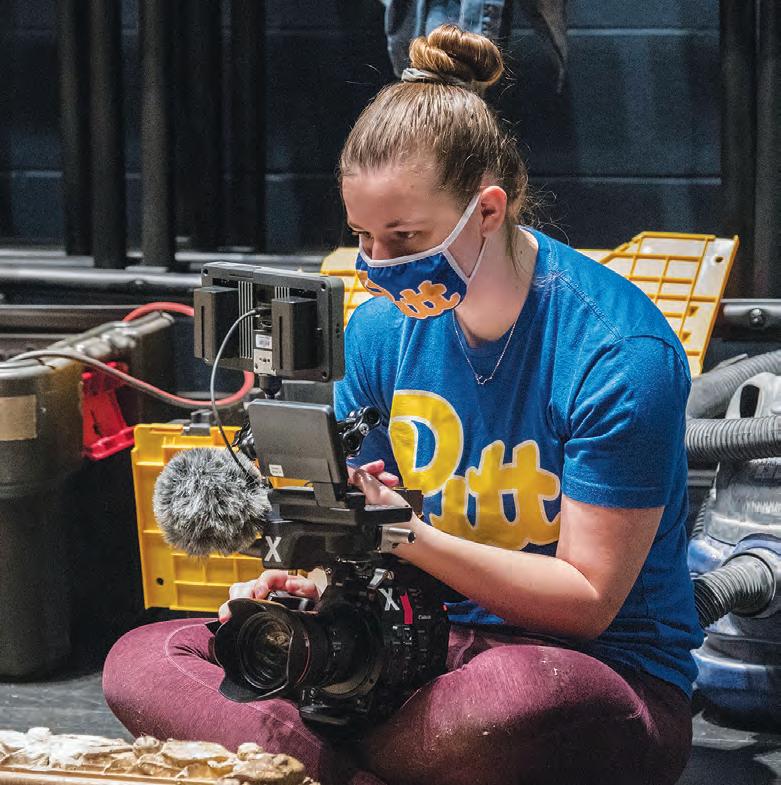
Senior Danica Andrews of Germansville, Pa., worked alongside the film crew.
Glenn Melvin '04
While Clark continued to paint in the bare spots on the canvas, Johnson created silicon molds of parts of the frame and used them to create replacements for the missing ornamentation.
Once the new plaster moldings were ready, Johnson added them to the frame, and cleaning began on the gilt frame.
Gilding is a process that leaves a fine coat of gold behind, and through the ages, many different chemical processes have been used to achieve golden effects. Johnson had to again apply his knowledge of historic techniques and chemistry to determine the best cleaning method.
Johnson and Clark’s time in Bradford working on the frame and the accompanying documentary provided the opportunities for four students to learn alongside professionals in their fields.
Senior Alexis Horning of Bradford, a psychology major with a minor in art, had a chance to observe and take part in the restoration of the painting.
“It’s been very interesting,” Horning said of her opportunity. “Walking into this restoration project, I knew nothing about it.”
Clark talked with Horning about how she created the paint to be similar to that used by Juglaris, explained color theory and technique and then handed Horning a brush.
“In my head, I was like, my goodness, be careful!” Horning said. “The brush strokes that I am used to didn’t work. It’s less of a brush and more of a pat. It was a little nerve-wracking, but it was a total new experience.”
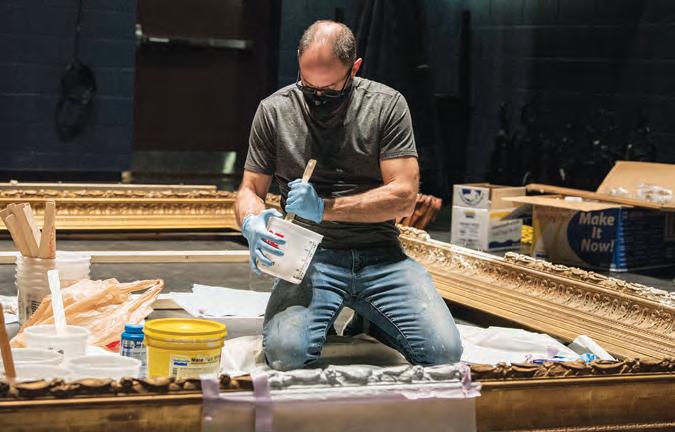
Conservator Jeff Johnson creates a mold of the frame to replicate lost parts of the plaster decoration.
Glenn Melvin '04
Horning said she loves that she contributed “a couple of little brush strokes” to restore the painting to its original beauty. “I was thrilled that I got to be a part of it. It gave me a newfound respect for things that have been restored.”
Horning also spent time with Johnson learning about the techniques used to create and restore the large gilt frame.
The three other students’ hands-on lessons lay with cinematographer Adrian Selkowitz, who is documenting the project as a film.
Hayley Madl, a senior history-political science major from Beaver, Pa., and Devon Briggs, a junior double major in history-political science and international affairs from Port Allegany, Pa., have been researching the history of the painting’s original owner and the hotel where it hung for 40 years before being crated and stored.
While Madl has conducted a lot of research in her college career, she said this was the first topic she had researched from scratch.
“The Bradford Landmark Society has been immensely helpful,” she said. It provided newspaper clippings and steered her toward other sources, such as the Smithsonian Institution, to work on finding the answers to new questions raised by the landmark materials.
While Madl is applying to doctoral graduate programs, she said she appreciated learning about a field she didn’t know much about.
For Briggs, it was also his first time conducting original research. In addition to working with the Landmark Society to research the former Emery Hotel, Briggs consulted with Marietta Frank, director of Hanley Library, and combed the scrapbooks of Lewis Emery’s granddaughter, Elizabeth Kennedy Fesenmyer, which are in the Hanley archives.
“We’ve gotten to see the whole picture, and now I see how much work goes into making a documentary,” Briggs said. “This whole thing has been a very eye-opening experience for me. “The fun part of the research has been looking at the primary sources and sifting and putting information into a timeline,” he said.
For help with the actual filming, documentarian Adrian Selkowitz turned to Danica Andrews, a senior broadcast communications major from Germansville, Pa.
Andrews said she was grateful to have the experience before she graduated in December. She met with Selkowitz during the summer. Then, he shipped her a professional-grade camera so she could record footage on campus and around town that could be used in the documentary while people are talking on camera.
She said that at first, carrying the expensive camera made her nervous, but she adjusted both to the camera and not having a professor there to guide and critique her.
“Having Adrian looking at my work was a real confidence boost,” she said.
Selkowitz said, “Danica has been able to handle all of the Bradford footage. Her footage looks terrific. She’s up for it.”
The painting and video will not only provide a valuable link between the campus and Bradford’s own gilded age of oil millionaires, but also serve as a teaching tool for PittBradford students as well as those from the community. Under black light, students will be able to see areas where the painting has been worked on.





